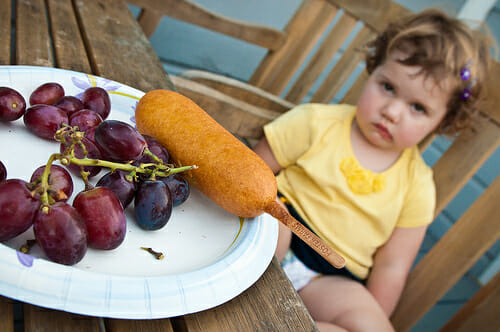Several years ago, I attended a continuing education program to give me more insight into treating children with a very limited diet. It totally changed my perspective on treating the “picky eater”. The Sequential Oral Sensory (SOS) treatment method uses a systematic desensitization approach to address the feeding/eating skills of a child, and it takes the family into account, as well.
But isn’t eating instinctive? Given enough time, won’t a picky eater eventually eat without intervention? Not necessarily. Parents should be aware of a few “mealtime myths”:
MYTH #1: Eating is the body’s number one priority.
First things first: we can’t eat if we can’t breathe or sit up. It should come as no surprise that breathing is a high priority activity, but eating is actually third behind breathing and postural stability in terms of the body’s priorities.
MYTH #2: Eating is instinctive.
We are born with primitive motor skills (such as rooting, sucking, and swallowing) that allow us to eat from birth to around three to four months of age. Around five to six months of age, however, eating becomes a learned motor behavior.
MYTH #3: Eating is easy.
Eating is actually one of the most complex physical tasks for children, as it’s the only one which requires all of the organ systems, and also requires that all of those systems work correctly. Eating is also the only task which requires simultaneous coordination of all of our senses.
MYTH #4: If a child is hungry enough, he will eat. He won’t starve himself.
For the 4-6% of children who have feeding problems, it is possible they will starve themselves. For the majority of children with feeding difficulties, eating doesn’t work and/or hurts, and no amount of hunger is going to overcome it. Children are organized simply; if it hurts, don’t do it – cry and/or run away. Even more frightening, appetite can become suppressed over time, such that a child no longer responds to appetite as a cue to eat.
The SOS approach considers the whole child and includes motor, oral, behavioral/learning, medical, sensory, and nutritional factor. In SOS therapy, a child might be presented with a variety of foods in a structured play-based situation so they are allowed to experience foods in a non-confrontational setting. For example, a child may gag or refuse to sit at a table when presented with a new or unfamiliar food, but with the SOS approach, the child will initially allow the food on a plate, then progress to being able to touch it with a finger (then the whole hand), progressing eventually to their face and ultimately to the child’s mouth. With every step of the therapy process the family is included, allowing for carry-over into the home environment.
Kid’s Creek Therapy works with both picky eaters and problem feeders through our Feeding Therapy program. If you or someone you know would like to learn more about how we can help your child, contact us for a free consultation.
Barb Hartshorn, Speech Therapist
Photo Courtesy David Goehring/Flickr








